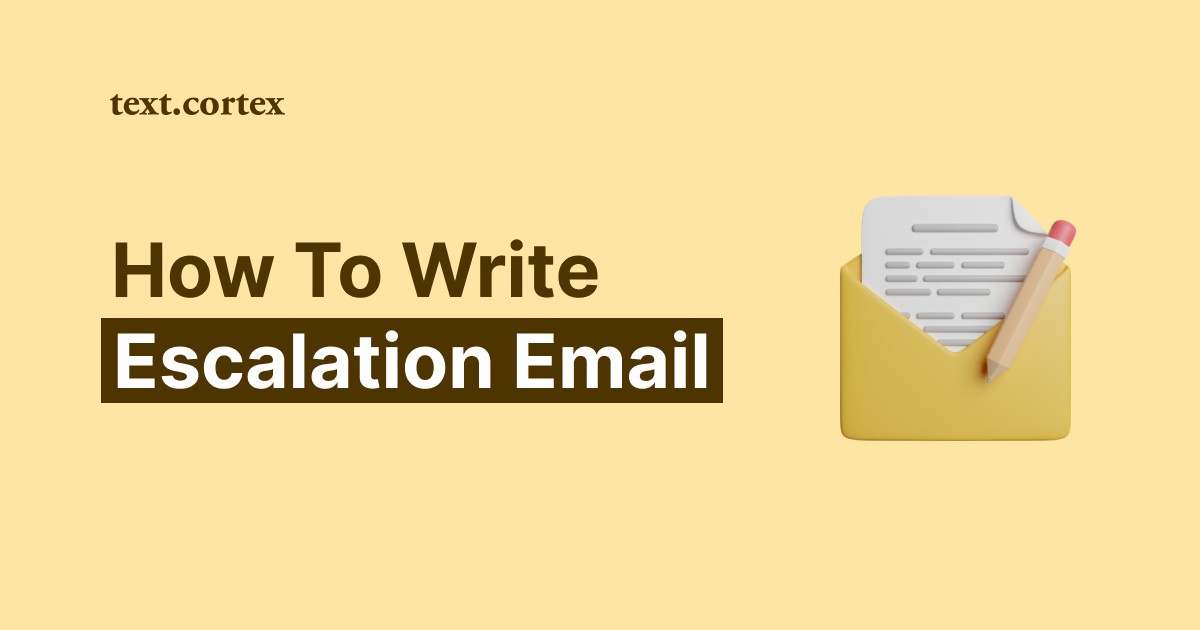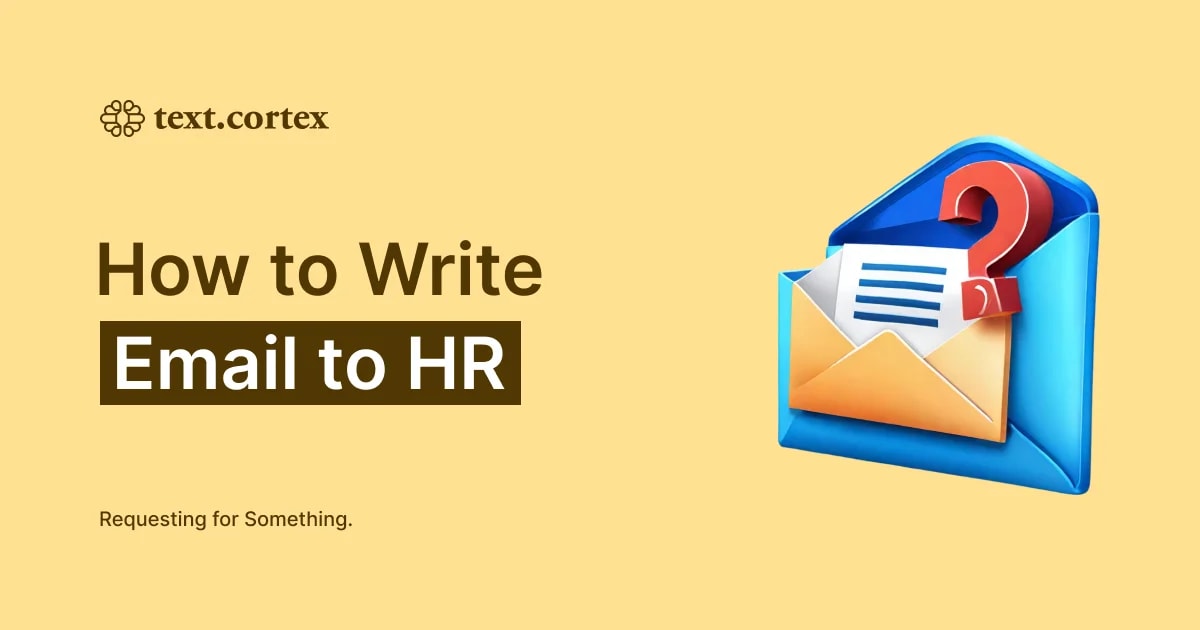Have you ever panicked over an ongoing business problem, wanting to alarm everyone concerned?
In such a complex situation, a well-crafted escalation email can take you a long way.
The real trick is finding that sweet spot between voicing your concerns and not coming across as the villain.

What's the best way to get started?
How do you express the urgency politely?
How to remain professional but get things done?
You probably asked yourself these questions while staring for hours at an empty document.
This article will guide you in mastering the art of writing an escalation email that effectively resolves issues.
Let’s begin!
What is an Escalation Email?
An escalation email is a trusted method in professional communication to bring attention to an issue or problem that requires urgent resolution.
Such emails are necessary when the standard transmission of information is not showing results.
Whether you're dealing with unresponsive customer support, handling projects, or trying to get noticed by upper management, our comprehensive guide is your secret weapon.
The primary purpose of escalation emails is to elevate the situation to a higher level without burning cities.
When to Escalate?
Before composing an escalation email, ask yourself:
💡 Is Escalation Necessary? If you figure out that you can quickly resolve the issue, there is no need for escalation.
💡 Did I Exhaust Other Options? Before contacting the company to escalate, familiarize yourself with a specific protocol they use to handle alarming situations.
💡 Do I Have All the Vital Information? We need evidence to support our urgency and claims. Incomplete and exaggerated escalation can prolong the resolution process.
However, the only recourse is to send an escalation email if there is no solution in sight.
We’ll go through some of the most common scenarios that drive into escalation:
1. Technical Errors ❗
Technology powers nearly every aspect of a company.
You don’t want to risk losing data or clients due to a technical crash, so promptly communicating the issue with the tech department is crucial.
2. Project Hiccups ❗
Unexpected challenges can appear in the middle of a project.
For whatever reason, the project stalls, so raising concerns with escalation email is necessary.
This way, we can obtain needed resources and review the existing strategies.
3. Staffing Challenges ❗
Whether it’s about employee conflicts, safety concerns, or potential harassment in a workplace, escalating the issue to an HR department is inevitable.
Does it sound like a lot?
Do not worry. We've got you covered! You can find the structure and content of an email explained in all the details.
What to Keep in Mind When Planning Your Escalation Email?
When planning your email, the first thing to consider is the main objectives you want to communicate.
Go through our checklist and set yourself ready to begin writing.
✅Mind Your Tone - By using a respectful voice, you represent yourself as professional, which enhances your chances of receiving a positive response.
✅Gather the Necessary Information - You must be precise when explaining the situation and include all details about the time, date, and people in question.
✅Think of a Solution - Escalating email without suggestions is incomplete. It can slow down the entire process of resolving an issue.
✅Refer to the Adequate Person - Escalation is all about urgency. You need to know who is authorized to deal with the existing situation to speed up the process.
How to Write Escalation Email in 6 Simple Steps?
We’ll go through the necessary steps of writing a quality escalation email!
1. Write an Attention-Grabbing Subject Line
The Subject line needs to identify the problem accurately. Let the recipient know the importance of communication from the start.
✨Example:
"Urgent Matter Requiring Escalation: [Brief Description of the Issue]."
💡ProTip
Zeno Chat can assist in creating effective and targeted subject lines.
Once you enter the email content and ask it for assistance, you will receive numerous subject lines to use.
2. Use the Appropriate Salutation
Begin with a formal salutation and use their full name and title. Urgency and informality do not go well together.
You want to emphasize the importance of the situation through formal greetings as well.
✨Example:
"Dear Mr. Marck Johnson,”
💡Be formal - when it comes to escalation emails, it’s best to put aside any friendly relations we have with the recipient.
3. Briefly Introduce the Recipient to the Issue
Briefly introduce yourself and your role within the company. State the purpose of the email and why you are escalating the issue. Be concise and to the point.
✨Example:
“I hope this email finds you well. As [Name of the project] coordinator, I am writing to escalate an issue regarding the project delay.”
4. Concisely Describe the Issue
Clearly describe the concern and issue that requires the escalation. Provide all the necessary information, such as time, date and any supporting evidence.
✨Example:
“As of [Date], the project in question, [Project Name], is [mention the specific delay, e.g., X days/weeks] behind the originally planned schedule. I have attached the progress reports for your review. These documents clearly illustrate the root cause of the delay, and I have highlighted the critical areas in the attached files [File Names].
💡Provide a brief overview of previous attempts to resolve the issue at lower levels. This way, you express the necessity of escalation.
4. Suggest a Remedy:
Express your willingness to assist in the resolution process, and offer any solutions that can be impactful. Demonstrate your commitment to the situation.
This step could be crucial. The solution you offer may be the best possible, and it will speed up the progress.
5. Request an Action
Clearly state what action you expect from the recipient or the higher authority to whom you are escalating the issue. Be specific and realistic in your requests.
✨Example:
“I kindly request your immediate intervention to investigate and address this project delay situation. To initiate the resolution process, I would appreciate it if you could offer the correction plan.”
6. Conclude:
Thank the recipient for their attention and assistance. You can end the email with a formal closing, such as “Sincerely” and your full name.
2 Examples of Effective Escalation Email Templates
If you need help crafting an effective escalation email, we provide three examples to help you speed up the process!
1. Example: Email for Technical Error
Subject: Urgent Escalation: Critical Technical Error
Dear Mr Marck Johnson,
I hope this email finds you well. I am writing to escalate a pressing technical issue that demands immediate attention.
As of [Date and Time] our systems encountered a critical technical error that has disrupted our operations. The error pertains to [describe the specific technical issue, its impact, and any affected systems or processes].
Despite our best efforts and the involvement of our technical support team, we have been unable to resolve the issue or identify its root cause. To provide a comprehensive understanding of the problem, I have attached relevant error logs, screenshots, and any available data pertaining to the issue [File Names].
This technical error has already resulted in [mention any specific consequences, such as financial losses].
I kindly request your immediate intervention to investigate and address this technical error. Specifically, I propose the following action: Convene an Emergency Technical Meeting. Schedule an emergency meeting involving our technical team, including key experts, to assess the situation and identify potential solutions.
I kindly request that this resolution plan be communicated to me by [mention the desired timeline] to ensure the swift resolution of this critical technical error.
I am fully committed to assisting in any way I can and am available to provide further information or discuss this issue as needed.
Thank you for your prompt attention to this matter.
Sincerely,
[Your Full Name]
[Your Contact Information]
2. Example: Email for Project Delays
Subject: Urgent: Project Delay - Escalation Notice
Dear [Recipient's Name],
I hope this email finds you well. I am writing to bring to your attention a critical matter regarding our ongoing project, [Project Name]. Unfortunately, we are facing significant delays that require immediate attention.
As you are aware, we set specific milestones and deadlines for this project to ensure its successful completion within the agreed-upon timeframe.
However, due to unforeseen challenges and bottlenecks, we have encountered delays that threaten to impact the project's overall timeline and objectives.
We have been experiencing resource shortages, both in terms of human resources and equipment, which have hindered progress.
It is essential that we address these delays promptly to minimize their adverse effects on the project. We need your immediate assistance to help us get back on track.
To that end, I kindly request to prioritize the project and allocate additional resources where possible to expedite the resolution of these issues.
I understand that this situation is not ideal, but together, we can overcome these obstacles and bring the project back on track.
Please confirm your understanding of this escalation email, and let's schedule a meeting at your earliest convenience to discuss the specific actions we need to take to address these delays effectively.
Thank you for your immediate attention to this matter.
Sincerely,
[Your Name]
[Your Title]
[Your Contact Information]
5 Common Mistakes to Avoid in Escalation Emails
While there are steps to ensure the success of your escalation emails, it's equally important to be aware of what not to do.
In this section, we'll provide a brief overview of the most important tips to help you understand what you should avoid doing.
❌Neutral Subject Line - State from the beginning the importance of the situation.
❌Sounding Overly Emotional - Even though escalations can sometimes be frustrating, keeping it professional and formal maintains the proper image.
❌Forgetting a Call-To-Action - Call to action is a crucial component that tells the recipient which exact steps you expect them to take in response.
❌Using Informal Language - Using slang and too-friendly expressions can undermine the seriousness of the situation.
❌Accusation without Evidence - Not including supporting evidence can hinder the recipient's ability to understand and address the issue. Attach relevant documents or data.
Write an Escalation Email by Using TextCortex!
Pin-pointing an issue and successfully delivering a message to a higher authority is a troublesome task.
What makes it even harder is when we have a serious situation that needs immediate reaction.
However, knowing how to write a well-structured and complete escalation email is a beneficial skill in the business world.
Why go through the trouble of writing escalation emails manually when AI can do it for you?
Let’s check out the TextCortex – an all-in-one writing solution for diverse content necessities.
What is TextCortex?
TextCortex is an AI-powered writing tool capable of assisting you with a wide range of textual tasks on your to-do list. It can:
🔥Rewrite sentences and adjust the tone to your preference.
🔥Help with almost any content form by offering over 60 customizable templates.
🔥Generate conversational responses in your preferred writing style with help of a Zeno Chat add-on.
🔥Translate your text into over 25 languages.
🔥Summarize, rewrite, and paraphrase your email for some extra formality.
Interested to try it out?
Join TextCortex today and unlock numerous features that will change your writing style forever!


.webp)

